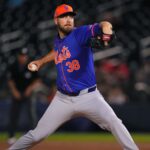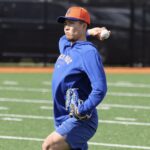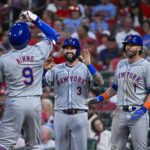
While we’re all excited for baseball to make its triumphant return, there may not be many people more excited than New York Mets first baseman Pete Alonso.
In a wide-ranging interview with the New York Post, there were plenty of things discussed. What interested me the most, though, were the snippets about himself and how he’s feeling after what was a weird and frustrating sophomore season in the big leagues. He still showed off his power (16 home runs and a .260 ISO) and his 118 wRC+ was comfortably above the league average. However, his .231/.325/.490 triple slash and 0.4 fWAR were not what he hoped for as an encore to his 2019 National League Rookie of the Year campaign.
What’s getting a lot of the headlines is how Alonso is feeling “dangerous” and is ready to drive in 130 runs (which would be a new single-season franchise record). I was drawn to the very specific and very unspecific goals he has for himself in 2021. The very specific one is winning a Gold Glove award, with the very unspecific one being to master the strike zone. So, let’s dig into the unspecific goal and see how his strong finish to 2020 could hopefully be a precursor for what’s to come.
Not a Huge Change Overall
Looking at a player’s season-long stats is obviously an important exercise, but in many cases, it doesn’t tell the whole story. This is true during a 162-game regular season, and that was still the case despite only 60 games getting completed this past year. If we put Alonso’s season-long plate-discipline numbers from the last two years side-by-side, there’s not a huge difference.
With a quick glance, there may even look to be some improvements.

Alonso’s swing rate and contact rate obviously both dipped between 2019 and 2020, but that drop in contact rate can be attributed to making less contact on balls outside the strike zone. As we can see, his contact rate on strikes actually increased slightly.
This progression led to similar walk and strikeout rates between these two seasons, as well. The first baseman’s walk rate went from 10.4% to 10.0%, while his strikeout rate went from 26.4% to 25.5%. There also weren’t huge changes in categories like average exit velocity (90.7 mph to 90.2 mph), barrel percentage (15.8% to 12.8%), or hard-hit rate (42.7% to 41.2%), according to Statcast.
What’s interesting, though, is that Alonso’s quality-of-contact took a huge step backward in 2020 when looking at his FanGraphs page. After posting a 42.2% hard-hit rate as a rookie, that number dropped down to 31.8% last season.
Breaking It Down Month-By-Month
If there wasn’t a huge shift in plate discipline when looking at season-long stats, then there must be something lying underneath the surface, right?
Without a huge last week of the season, Alonso’s overall 2020 statistics would’ve looked dramatically different than they actually do. If we back it out and look at his production through the end of August (97 wRC+ and .172 ISO) and from the beginning of September on (150 wRC+ and .384 ISO), it’s night and day. There was also a clear shift in his aggressiveness at the plate:

The biggest takeaway from the above table is that Alonso not only got more aggressive in all situations, but it also led to more contact inside the strike zone. There wasn’t a huge shift in overall hard-hit rate between these periods of time (30.5% to 33.3%), but making more contact within the strike zone will usually lead to better results.
This aggressiveness on strikes needs to stick around in 2021. The “mastering the strike zone” part will likely pertain to decreasing his chase rate.
Where The Progress Needs To Be
Remaining aggressive within the strike zone and cutting down on chasing non-strikes has a number of obvious domino-type effects on the rest of Alonso’s profile. Theoretically speaking, his swinging-strike rate will take a dive, his walk and strikeout rates will improve, and his quality-of-contact will head back in the right direction.
It’ll also have a positive impact on the most important batted-ball event for the 26-year-old: fly balls.
If we look at all batted-ball event categories, the only significant negative regression he saw was in fly balls. Alonso experienced similar results from year-to-year in grounders (35 to 31 wRC+ and 26.6% to 24.1% hard-hit rate) and line drives (316 to 365 wRC+ and 50.7% to 48.0% hard-hit rate). Fly balls, though? His wRC+ went from 335 to 217, while his hard-hit rate went from 53.8% to 32.3%.
For someone who relies on fly balls for virtually all of his homer power (67 of his 69 career dingers have come on this batted-ball event), this is an area that needs a lot of attention. But it’s not like Alonso needs to actually focus on how he hits fly balls — he needs to… master the strike zone more. Putting himself in a position to do damage more often on better pitches will help those fly-ball numbers get back to where they were before.
Going through a rough sophomore season in the big leagues is never fun for anybody. However, Alonso is a year older and that experience has made him wiser, which will hopefully lead to positive developmental strides as he continues closing in on his physical prime.














